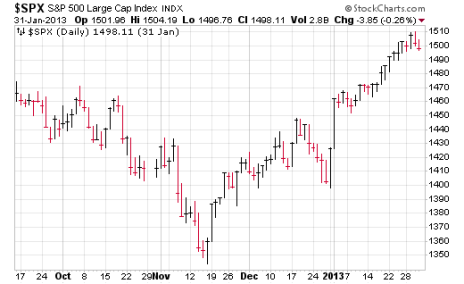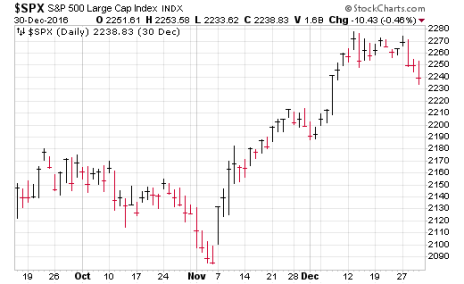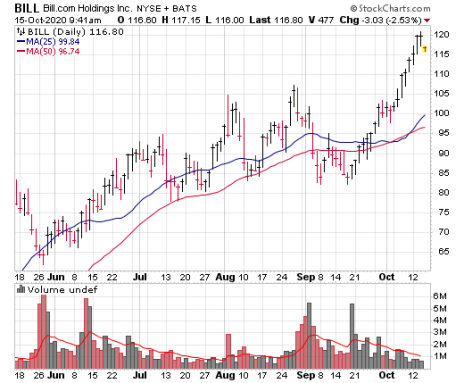The presidential election is looming, and it’s tempting to get your portfolio prepared for any outcome. Here’s what you actually should do.
This will be my last Cabot Wealth Daily column before the U.S. elections on November 3, so I figured I’d dive into the question I’m increasingly getting, which is: How should we adjust our portfolios ahead of the election?
My answer: Do nothing. And the reason isn’t because I have some great insight into what the election will hold and/or (more important) what it means for the overall market and certain sectors. No, it’s because of an old market truism that I’ve seen play out dozens of times: Trouble usually comes from where it’s least expected.
Said another way, when everyone is focusing on something, it’s rare (not impossible, but rare) for it to really cause the market to get hit. Instead, it’s usually the things few are focused on (the pandemic this year was a perfect example) that really give the market headaches, at least if you’re talking about a big-picture bull market.
Elections, while carrying some mystery, are obviously something many pay attention to. It’s not that everyone knows what the results will be but that the hedging/positioning occurs before the event. Throw in the fact that dire predictions (by both sides) are usually exaggerated, and reactions to well-followed events are usually either short-lived or the reaction is the opposite of what people think.
[text_ad]
How the Market Reacted to Previous Elections/Events
Check out the following examples—please note I’m not touching the politics with a 100-foot pole here, just describing the prevailing views at the time.
In 2012, after Barack Obama won re-election, the market dove sharply the following day as many thought a Mitt Romney win was possible (and would be better for the market). But it turned out to be a one-day event—stocks advanced after that and, once the fiscal cliff deal was inked, took off on a huge bull move in 2013.
In the summer of 2016, the market was coming out of a two-year funk, and all of a sudden Britain voted to leave the EU. And the reaction was awful! But again, it was two days, following which things immediately snapped back; some rare blastoff indicators actually flashed during that rebound that portended great things over the following year.
Then, of course, there was the 2016 presidential outcome, which not only surprised most observers, but also surprised most investors in terms of the reaction, with the market taking off on the upside, led by cyclical stocks.
The point here isn’t that a sharp reaction post-election isn’t possible—in fact, based on recent history, it’s somewhat likely. But (a) it’s impossible to predict which direction any reaction occurs, and (b) these moves rarely crack the underlying environment of the market (choppy, up or down).
Long story short, yes, there’s event risk with something like the upcoming election, no question. And the immediate aftermath could surely be hectic. But it’s always best to stick to your system—guessing the results (and the market’s reaction to those results) correctly could give you a little boost if you’re right, but if you’re wrong and go against the underlying trend, things can get ugly in a hurry.
Encouraging Market Trends Developing
And today, that underlying trend is up! Three weeks ago, the market looked pretty dreadful—not only had the intermediate-term uptrend cracked, but very few stocks were hitting new highs and most growth stocks looked like they needed time to digest their massive March-July advances.
But since then, the action has been extremely impressive, led by individual stocks. In fact, on Monday, we saw the largest number of net new highs (stocks hitting new highs on the day minus those hitting new lows) that we’ve seen all year on both the NYSE and Nasdaq.
Translation: A lot of stocks are working. Short-term, such a rush of buying can often lead to a pullback—maybe with the election and earnings season coming, investors will take a few chips off the table in the coming weeks. But bigger picture, it’s a great sign, especially coming after a multi-week rest period for most growth stocks.
But which ones to buy? Look for stocks that have shown some big-volume buying of late while moving higher close to (or out to) new highs. Then you can look to buy the first pullback, which is a high-odds entry point. Here are a couple of names to watch:
2 Growth Stocks Hitting New Highs
Alibaba (BABA) looked to be blasting off in early July (huge-volume breakout) and again in late August, but each time, the stock got yanked down by the market and/or growth stocks. Now, though, after a bullish Investor Day, the buyers are back—shares spiked on huge trading volume a couple of weeks ago, and have seen five more above-average volume buying days since as the stock has moved to new highs. It really doesn’t look like a bad buy point around here, though pullbacks would be even better.
Another one I’ve been spying for months but never could quite get going (until now) is Bill.com (BILL), which has a story that’s easy to understand and has a long runway of growth ahead. The company is bringing thousands of small businesses (those with 2 to 500 employees—i.e., not sole proprietorships) into the modern age by getting rid of these firms’ paper-based bills, invoices, contracts and more, replacing them with its efficient platform that handles everything electronically and automatically syncs to account systems and many financial outfits. That’s a huge market, as more than 90% of its target market still does most of this stuff by paper!
Not surprisingly, growth has been rapid and reliable (especially “core” revenue that includes subscription and transaction-related sales) in recent quarters. The stock, though, has been more challenging, with a huge breakout in May but then lots of choppy, up-and-down action—for months, in fact, BILL really didn’t outperform the market.
But now the stock has changed character—it’s been persistently advancing for a few weeks, has easily cleared its old highs, and importantly, has done so on many days of beefy volume. Pullbacks would be tempting going forward.
[author_ad]







